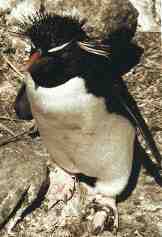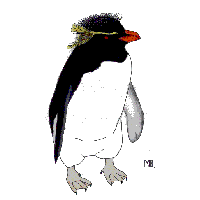


|
|
| |||



| ||||
.
Rockhopper Penguin by Mike Bingham Electronic download: $3.95 Paperback: $10.95 Proceeds fund our Research
Organisation for the Conservation of Penguins
Alvear 235
Casilla 263 |
|
.
Rockhopper Penguin
Southern Rockhopper - Eudyptes chrysocome chrysocome
Breeding Range:
World Population: Length - 52cm. World-wide there are 3 subspecies of Rockhopper penguin; Southern, Eastern and Northern. Rockhopper penguins are amongst the smallest of the world's penguins, having an average length of around 52cm, and an average weight of about 3kg. A yellow stripe above each eye projects into a yellow crest, and these are joined behind the head by a black occipital crest. The eyes are red, the short bulbous bill is reddish brown, and the feet and legs are pink. The females are slightly smaller than the males, but have similar plumage.
 ROCKHOPPER PENGUIN: Drawing by Mike Bingham Rockhopper penguin breeding colonies may be very large, with up to a hundred thousand nests at a single breeding site. Nesting densities range from 1.5 to 3 nests per sq.m., and colonies are often shared with nesting albatross or cormorants. Rockhopper penguins not only return to the same breeding site each year, but they also utilise the same nest, which they refurbish with stones, sticks, vegetation or any other suitable material. The preferred nesting sites are steep rocky gullies, above approaches into deep water. Such sites may be vegetated by grasses or dwarf shrubs, but long-established colonies will generally have destroyed most of the natural vegetation surrounding the colony, and worn a pathway from the sea up the rock-face. Rockhopper penguins regularly bathe and drink fresh water, and most breeding sites are close to natural springs or freshwater puddles. The breeding cycle begins in early October, with males arriving at the breeding site a few days earlier than the females. Copulation begins as soon as the females arrive, and egg-laying takes place in early November. Two eggs are laid 4 - 5 days apart, with the first egg hatching after the second. The first egg, at around 80g, is considerably smaller than the second egg of around 110g. This strategy aims to rear just one healthy chick under a wide range of circumstances. The second egg is generally brooded at the rear, where the temperature is more stable, and where it is less prone to being lost or stolen. In Eastern and Northern Rockhopper penguins it is almost unheard of for both chicks to be reared, but the Southern Rockhopper penguin is capable of rearing both chicks to fledging when conditions are favourable. Even so, Southern Rockhopper penguins show little annual fluctuation in population size and chick rearing success, and annual breeding success never exceeds 1 chick per breeding pair for the colony as a whole. Incubation of the eggs takes around 33 days, and is divided into three roughly equal shifts. During the first shift both parents are in attendance. The male then goes to sea to feed while the female takes the second shift, and he returns to relieve the female for the third shift. The male remains on the nest until the eggs hatch, and continues to brood for the first 25 days, while the female brings food for the chicks. Such a system of extended shift duration requires lengthy fasts for both parents, but allows them to forage further afield than would be the case if they had a daily change-over. The newly hatched chicks may have to wait for up to a week before the female returns with their first feed. During this period chicks are able to survive on existing yolk reserves, after which they begin receiving regular feeds of around 150g in weight. By the end of the 25 days of brooding, chicks have developed their mesoptile plumage, and are receiving regular feeds averaging around 600g. By this stage they are able to leave the nest and creche with other chicks, allowing both adults to forage to meet the chicks' increasing demands for food. Rockhopper penguin creches are not generally as large as for species such as Gentoo penguins, possibly due to the more rugged terrain, and chicks creche into numerous small groups scattered throughout the colony. Chicks completely lack the yellow markings of the adult birds, and even the bills are black. As chicks moult into adult plumage, the colony is joined by pre-breeding birds arriving to moult. These birds are distinguished from newly fledged chicks by a faint yellow stripe above the eye, and a reddish brown bill. The crest is not developed until birds mature. Rockhoppers do not breed until at least 4 years of age, but have been shown to live for up to 25 years in captivity. Despite being amongst the smallest of penguins, Rockhopper penguins are perhaps the most aggressive. They show little fear of people, or of birds and animals larger than themselves. Anything that comes within range of an incubating bird will be pecked, including another Rockhopper, or the long wings of neighbouring albatross. Nevertheless, Rockhopper penguins can be very gentle with their partners, and allopreening (mutual preening) is common. Chicks fledge at around 10 weeks of age, and adults then spend 20 - 25 days at sea building up subcuticular body fat reserves in preparation for their annual moult. The moult lasts for around 25 days, and the birds then abandon the breeding site and spend the winter feeding at sea, prior to returning the following spring. Rockhopper penguins are opportunistic feeders, and around the Falklands are known to take varying proportions of crustaceans (Euphausia lucens, E. vallentini, Thysanoessa gregaria and Themisto sp.), squid (Gonatus antarcticus, Loligo gahi, Onychoteuthis sp, and Teuthowenia sp.) and various small fish. Foraging dives rarely exceed 100m in depth, but feeding in groups is common. Eastern Rockhopper penguins have undergone major declines over recent years, probably because of commercial fishing, although little research has been done to confirm this. Northern Rockhopper penguins have declined by over 90%, and commercial fishing is the principal cause. As for Eastern Rockhoppers, little detailed research has been done on Northern Rockhoppers to obtain precise population statistics. Southern Rockhopper penguins are by far the best studied, with population censuses having been performed periodically since the 1930s. The Falkland Islands held a population of 2,500,000 breeding pairs when counted by the British Antarctic Survey in 1984, which is supported by the census of 1932/33 conducted by the Government Naturalist A.G. Bennett. The Falkland Islands commercial fishing industry was established in 1988, and by 1995/96 the Rockhopper population had crashed to just 297,000 breeding pairs, a decline of 88% in just 11 years. Nearby populations in South America, which are not subject to commercial fishing, are stable or increasing in population. The decline is unique to the Falklands. Evidence of this massive Falklands decline can still be seen from the breeding sites themselves. Falkland Islands colonies are all old colonies, where the ground has generally been cleared of vegetation by years of occupation. At most sites, a pocket of nests now lie at the centre of an area cleared by a colony that was once much larger. They look like a large lake that has dried up, leaving just a puddle of water in the middle of the dried up lake bed. By contrast, breeding sites in Chile and Argentina contain new, middle-aged and old colonies, indicating a natural cycle of fluctuation and regeneration. In particular, populations on Staten Island (Argentina) and Isla Noir (Chile) are expanding into new areas of dense vegetation, indicating population increases. Since 1995 the Falklands population has managed to stabalize at around 300,000 pairs. This has been possible due to the reduction in food demand caused by the 88% decline, and changes in diet that has reduced dietary overlap with commercial fishing to just 11%. This has allowed the population to establish a new equilibrium, albeit at a much lower population size. The large scale decline in Rockhopper penguin populations has been of such magnitude as to justify treating the species as globally threatened according to the IUCN criteria. In September 2001 the IPCWG recommended the exclusion of large scale commercial fishing from within 30 miles of penguin breeding sites in the Falkland Islands. So far the Falkland Islands Government have refused to adopt this measure, and penguin populations continue to be damaged as a result. In the Falkland Islands, Rockhopper Penguins are a major tourist attraction, and a number of sites have large numbers of visitors every year. Comparison of sites which have large numbers of visitors, with those that have none, show no differences in breeding success or population trends. Rockhoppers have no fear of people, treating all invaders into their space with the same aggression as that shown to a trespassing neighbour. Provided that visitors do not try entering the colony, breeding birds will generally carry on with their business as usual, and a calm approach to within about 5m of the colony is likely to leave one surrounded by inquisitive birds. This tolerance provides an excellent opportunity for a sustainable tourist industry, which could give added incentive to safeguarding future populations for more than just their intrinsic value.
CLICK HERE to Adopt a Penguin of your very own.
|